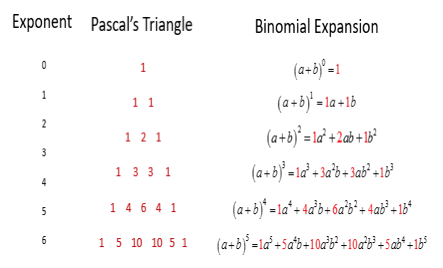Pascals Triangle
Pascal’s triangle is a triangular array constructed by summing adjacent elements in preceding rows. Pascal’s triangle contains the values of the binomial coefficient. It is named after French mathematician Blaise Pascal.

Binomial expansion in Pascal’s Triangle

All the extreme left and right boxes contain the number 1. The center boxes are a sum of the two numbers above it. For example 1 + 3 = 4.
Who was Blaise Pascal?
Blaise Pascal (1623 - 1622) made many contributions and inventions in mathematics and physics. His contributions to math include Pascal’s triangle and probability theory. Blaise Pascal was also one of the first few contributors to the early digital calculator.

Blaise Pascal
Patterns in the Pascal’s Triangle:

Some patterns that can be seen in the pascal’s triangle include the numbers found in each diagonal. The leftmost diagonal has only number one. The second diagonal has triangular numbers followed by tetrahedral numbers and then pentalobe numbers.

The triangle is also symmetrical. The numbers on the right occur in a mirror image on the left.

Another pattern can be seen in the sum of all the numbers in a row. The sums of each row double as they move to the next row (powers of 2).

If you color the Odd and Even numbers, you end up with a pattern same as the Sierpinski Triangle.

If you make a pattern by going up and then along, then add up the values you will be able to form the Fibonacci sequence. (The Fibonacci Sequence starts “0, 1” and then continues by adding the two previous numbers, for example, 3+5=8, then 5+8=13, etc).

For the second diagonal, the square of a number is equal to the sum of the numbers next to it and below both of those. Examples: 32 = 3 + 6 = 9, 42 = 6 + 10 = 16, 52 = 10 + 15 = 25.


Each line is also an exponent of 11. For example, the first line is 11 to the power 0 which is one, followed by 11 to the power 1 or 11. The third line is 11 to power 2 or 121 and so on. When it comes to 11 to the power 5, the digits just overlap as shown in the second image. The same happens with 11 to power 6.
What are the uses of Pascal’s Triangle?
The Pascal’s Triangle can be used to find combinations, list number patterns (triangular, tetrahedral and pentalobe) numbers, the possibility of heads and tails with a number of coins or even to show coefficients through binomial expansion.
Citations:
• https://sites.google.com/site/funproblemsolving/topics-1/pascal-s-triangle
• https://www.britannica.com/biography/Blaise-Pascal
• https://www.onlinemathlearning.com/binomial-theorem-3.html
• https://study.com/academy/lesson/blaise-pascal-contributions-inventions-facts.html